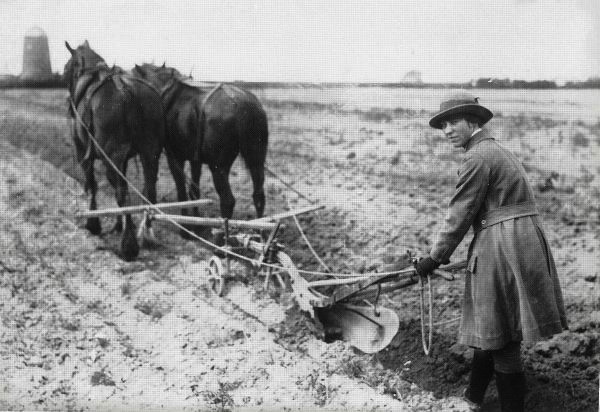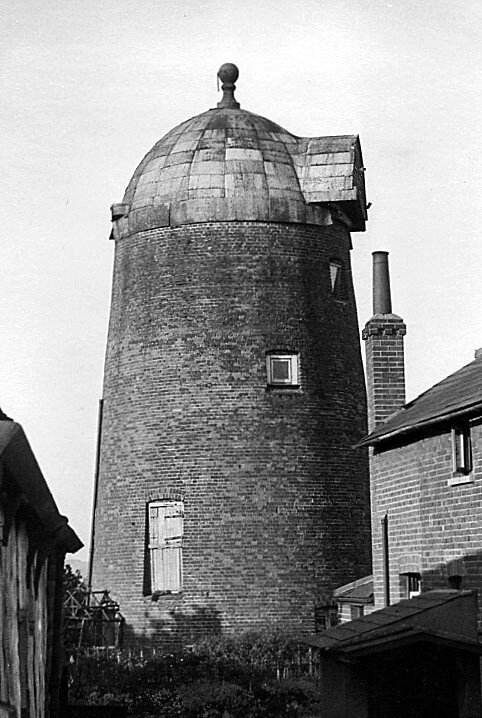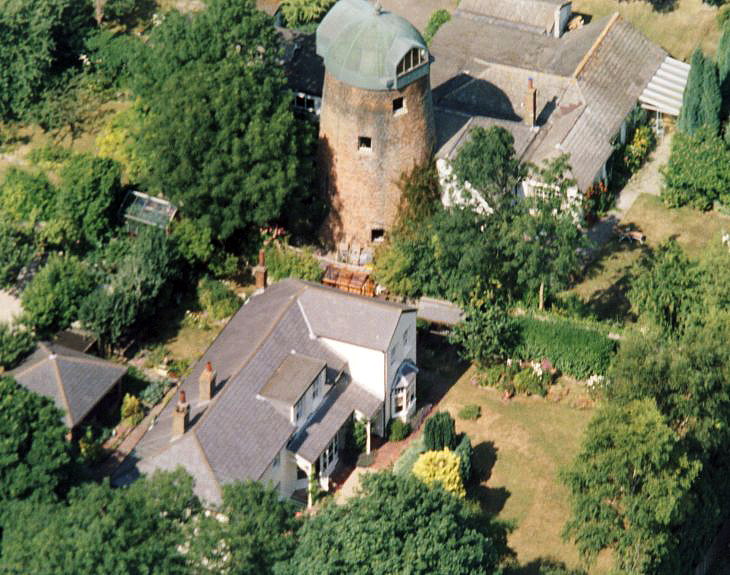|
THE LIDDINGTON FAMILY
About this time William took as his assistant a nephew, 16-year old
Thomas Liddington, who by the mid-1870s had moved his family into
Mill House and had also acquired sufficient experience to be classed
as a ‘master miller’. Thomas worked the mill assisted by Henry Liddington and Harry Robinson, who lived next door. By then milling
was not Thomas’s sole business activity; dealing in corn and
retailing flour and other foodstuffs had also become important.
In 1876 the mill was put up for sale by auction, being described in
the particulars as a complex covering a three-acre site . . . .

Fig. 8.3: auctioneer’s
particulars of Goldfield Mill in 1876
Although not recorded, it appears that Thomas Liddington bought the
property. In retrospect, this proved to be a poor investment, for by
then milling was becoming a more highly mechanised trade and as the
years passed Goldfield windmill could not compete favourably in the
flour trade with Thomas Mead’s increasingly modern steam mill at Gamnel Wharf. In 1888 Thomas Liddington was forced to file for
bankruptcy, the application being heard in Aylesbury County Court
where it was recorded that his liabilities amounted to £1,176. 3s. 3d.
with a deficiency of £269. 11s. 7d. Described as a miller and farmer,
Thomas claimed that the causes of his failure were a decline in
trade, bad debts and other losses incurred due to his horse and
cattle dying. But this was not the only disaster to befall the Liddington family, for Henry’s dealings with customers were not
always scrupulously honest (see Liddington in
Chapter IV).
JAMES WRIGHT,
GOLDFIELD’S LAST MILLER
Who held the mill during the next few years is unknown, but after
1888 it was worked by White & Putnam, a partnership that operated
several local mills. At some stage — the records of exactly when are
conflicting — James Wright, the miller at Hastoe steam mill, about a
mile and a half from Tring, took over at Goldfield. He is shown as
being miller at both sites until about 1902 by which time he had
moved to Goldfield.
Being familiar with steam milling it was natural that James should
use auxiliary power at Goldfield and a 6 hp steam engine was duly
installed to work a pair of grinding stones, the windmill driving an
oat crusher to provide animal feed when the wind was favourable.
James Wright’s son, Herbert, born in the Mill House in 1897, is
quoted as saying . . . .
“. . . . when I was ten years of age I was strong enough to stoke
the engine boiler and maintain the water pressure as well as help
the miller dress the stones when they had to be sharpened.”
Herbert Wright goes on relate that during his father’s tenure at
Goldfield, the mill was owned by Thomas Butcher & Son, bankers, of
Tring High Street. How Butcher’s Bank [13] came to own the mill is
unknown, but it seems possible that they acquired it following
Thomas Liddington’s bankruptcy, perhaps as a foreclosure on an
outstanding mortgage.
The two systems of wind and steam power ran in tandem until around
1904 when the sails of the windmill were removed. Even so, it could
be that the milling business was still not yielding sufficient
profit, for two years later the Bucks Advertiser reported that over
an acre of grazing land at Goldfield had been sold for the sum of
£9. 2s. 6d.
The viability of the mill at this time appears to have depended
largely upon a contact with the Rothschild Tring Park estate for
crushing oats as for animal feed on its many farms. The contract
ending in 1908, James left Goldfield to take over the tenancy of
Brook End water and steam mill situated some three miles away on the
border of Ivinghoe and Pitstone, taking its water supply from the
Whistle Brook. He is recorded here in 1911 as ‘miller, baker and
confectioner’, but Herbert Wright records that after
his father took over Brook End watermill, [14] “he was forced to give up”
in 1913, being unable to compete with the large milling firms.
THE WINDMILL ABANDONED
Goldfield mill was then put up for auction by William Brown & Co.,
The Bucks Herald reporting that . . . .
“Considerable interest was manifested in Tring and the surrounding
district regarding the sale of Goldfield Windmill, one of the most
well known landmarks in the neighbourhood. The property comprised
the windmill; two dwelling houses; numerous outbuildings; and a
valuable meadow of about two acres, with a long frontage to Miswell
Lane. The property stands at a high and healthy elevation and
commands most perfect scenery of the Vale of Aylesbury and the
Chiltern Hills, and the downs and woodlands of the Ashridge estate. Messrs. W. Brown & Co. submitted the whole property by auction on
October 30th but the bidding did not reach the reserve figure and is
now to be dealt with privately.”
In 1911 Brown & Co. again advertised the complex, but the outcome is
unknown. It is likely that milling had ceased following James
Wright’s departure, for by this time small milling concerns saw
their business dwindling in the face of competition from much larger
and more efficient roller mills. However, the living accommodation at Goldfield continued to be used
and Miriam Wright, who in the period 1916-21 lived with her parents
in one of the cottages, remembered that during WW I soldiers used
the top windows of the mill for signal practice.

Fig. 8.4: Myril Smith, a land
army girl, ploughing during WWI.
Goldfields Mill is in the
background.
Myril lived at the ‘Hollies’ in Brook Street, now long demolished
RESTORATION OF THE GRANARY
AND COTTAGE
In 1919, the entire complex was eventually sold — it is believed for
£1,000 — to a Mrs Cunningham from Rhodesia. This lady then
constructed a dwelling for herself and her family in the granary
and attached cottage, later turning the barn into a bungalow for her
daughter. When Mrs Cunningham died in 1955, the house passed to
Peter Bell, a journalist for the British Farmer and Stockbreeder
magazine, but the windmill continued in its state of dereliction.
In 1946 the tenancy of the adjacent Mill House cottage was acquired
by a well-known local lady, Phyllis Thomas, librarian at the Akeman
Street Zoological Museum, who lived there for many years until
forced to leave by her increasing frailty (she died in 1990 aged
102). In 1973 she wrote a letter to Hertfordshire Countryside
magazine in which she said . . . .
“. . . . I remember Herbert Wright as a small boy helping his father
. . . . My sisters and I would frequently walk up Miswell Lane (in
very truth a country lane in those days where one could gather
primroses and blue and white violets) to purchase eggs and other
farm produce from Mrs Wright. It was a great treat to be allowed to
climb the ladder-staircase of the mill, all white with flour dust,
and gaze through one of the little windows, at the lovely, unspoilt
Chiltern countryside . . . . [15] All around were meadows and farm land
and, directly in front, the famous ‘goldfields’, a sheet of yellow
buttercups.”
The Mill House and its adjoining granary now form a single dwelling,
one that has been sympathetically restored and modernised by its
present owners. Some of the original fittings have been
incorporated, including internal doors (complete with their
latches), cupboard doors, wooden beams, iron brackets and a
brick-lined cellar. The cast iron pump from the granary remains,
while the old well it tapped into is hidden beneath the kitchen
floor. Outside, old bricks have been re-used in some of the paved
areas and two of the windmill’s grinding stones now make attractive
garden features.

Fig. 8.5: the miller’s
cottage
During the 1960s, when new housing was being built in the Icknield
Way area, Tring Council ensured that the sad-looking old windmill
would not be forgotten entirely by naming three new roads Windmill
Way, Mill View Road, and Fantail Lane.
RESTORATION OF THE WINDMILL TOWER

Fig. 8.6: the mill prior to
restoration
The windmill’s fortunes improved some years later when an American
artist applied for permission to convert both the windmill and
adjacent barn to a dwelling and to add an extension to form guest
accommodation. But conversion of an old building is not a simple
matter, and this was explained in one of a series of articles
featuring unusual homes that appeared in the Post Echo of
September 1979 . . . .
“. . . . the previous owner gathered in the barns and milking sheds
which huddle around the old mill and made the whole thing into a
place of rambling spaciousness. There’s a good reason for this. A
windmill may be very stout — walls start at two and a half feet
thick at the bottom and taper to one and one and a half at the top —
and snug, but it’s a problem to put water pipes in. On outside walls
they disfigure the place: same goes for the inside walls.
So the builder left them out, which ruled out a kitchen and bathroom
in the tower . . . . The original lead cap is now an ornament in the
back garden. The man who converted the mill was so concerned with
retaining the original effect, and so unconcerned with the expense,
that he put in a glass fibre replacement, impregnated with copper
crystals. . . .”
When the windmill was again offered for sale in 2004, the sales
particulars described five circular rooms, some with the old beams
and timber cog wheels, and a tower room with spectacular views.
Goldfield windmill now claims the distinction of Grade II listing,
as well as being the only remaining tower mill in Dacorum.

Fig. 8.7: aerial view of Goldfield
Mill |